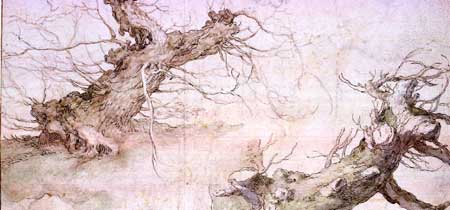
Abraham Bloemaert, Studies of Pollard Willows, (pen and brown ink, green watercolor
over traces of black chalk, 210 x 310 mm), Metropolitan Museum of Art New York,
Rogers Fund, inv. no. 1970.242.3
Curator
Susan Donahue Kuretsky, Vassar College
Curator’s information
This exhibition comprises 93 paintings, prints and drawings from American collections that illustrate the transformative effects of time and circumstance on the physical world, as explored by Dutch artists of the 17th century. Most are landscapes featuring architectural ruins (either local or Italianate), but related themes are also included, such as studies of ancient trees and other rustic motifs, depictions of fires and floods, and a few vanitas still lifes and images that illustrate various kinds of bodily transformation. The intention of the exhibition is to stimulate thinking about Dutch artists’ pervasive interest in ruins, while drawing attention to the new consciousness of time that developed during this period.
Museum press release, 18 July 2005
The John and Mable Ringling Museum of Art will offer a far-reaching exhibition when it presents Time and transformation in seventeenth-century Dutch art, on view from August 20 through October 30. This landmark exhibition is the first to examine how 17th century Dutch artists included the effects of time and circumstance upon the physical world into their work.
Landscape paintings with ruins, scenes of weathered cottages, still lifes that feature human skulls and pictures of newsworthy catastrophes were among the notable subjects of Dutch art of the Old Masters.
Time and transformation draws together a wide range of exceptionally fine art work from The Frances Lehman Loeb Art Center at Vassar College, Poughkeepsie, N.Y., from private holdings and from collections of more than a dozen major American museums, including the Ringling Museum of Art. It was organized with support from the Samuel H. Kress Foundation. The exhibition encompasses some 90 paintings, drawings, prints and illustrated books ranging from 1600 to 1690. Among the artists represented are Rembrandt van Rijn, Jacob van Ruisdael, Aelbert Cuyp, Joachim Wtewael, Abraham Bloemaert, Hercules Segers and Daniel Vosmaer.
“The Dutch used this kind of imagery both to recall their communal past and to reflect upon the varied conditions of life in the present,” said Susan Donahue Kuretsky, the Sarah Gibson Blanding Professor of Art at Vassar and the exhibition’s organizer. “This exhibition focuses broadly on this material and its inclusion may allow us to further understand the story of the complex relationship between art and life in the Dutch Republic.”
Ringling Museum associate curator Joanna Weber and exhibition curator for this traveling show, said “We have exquisite Dutch art in our own permanent collection that works beautifully with this exhibition. This magnificent array of artwork affords us the rare chance to see how time transforms the physical world with decay and deterioration.”
Catalogue
The catalogue offers an introductory essay and entries on all works in the exhibition by Susan Donahue Kuretsky with additional essays highlighting significant aspects of the material by Walter Gibson, Catherine Levesque, Erik Löffler, Lynn Orr, and Arthur Wheelock. The catalogue is available for purchase in the Ringling Museum Store
Other venues
Poughkeepsie, New York, Frances Lehman Loeb Art Center, Vassar College (8 April-19 June 2005)
Louisville, Kentucky, J.B. Speed Art Museum (15 January–15 March 2006)
